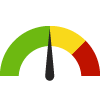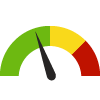Search for Indicators
All Data
Indicator Gauge Icon Legend
Legend Colors
Red is bad, green is good, blue is not statistically different/neutral.
Compared to Distribution
 the value is in the best half of communities.
the value is in the best half of communities.
 the value is in the 2nd worst quarter of communities.
the value is in the 2nd worst quarter of communities.
 the value is in the worst quarter of communities.
the value is in the worst quarter of communities.
Compared to Target
 meets target;
meets target;  does not meet target.
does not meet target.
Compared to a Single Value
 lower than the comparison value;
lower than the comparison value;
 higher than the comparison value;
higher than the comparison value;
 not statistically different from comparison value.
not statistically different from comparison value.
Trend

 non-significant change over time;
non-significant change over time; 
 significant change over time;
significant change over time;  no change over time.
no change over time.
Compared to Prior Value
 higher than the previous measurement period;
higher than the previous measurement period;
 lower than the previous measurement period;
lower than the previous measurement period;
 no statistically different change from previous measurement period.
no statistically different change from previous measurement period.
State: Wisconsin
Health / Alcohol & Drug Use
Value
Compared to:
State: Wisconsin Adults who Binge Drink
State: Wisconsin Adults who Binge Drink
23.4%
(2020-2022)
Compared to:



Prior Value
(23.8%)
Prior Value compares a measured value with the previously measured value. Confidence intervals were taken into account in determining the direction of the comparison.

Trend
This comparison measures the indicator’s values over multiple time periods.<br>The Mann-Kendall Test for Statistical Significance is used to evaluate the trend<br>over 4 to 10 periods of measure, subject to data availability and comparability.
State: Wisconsin Age-Adjusted Death Rate due to All Drug Overdose
State: Wisconsin Age-Adjusted Death Rate due to All Drug Overdose
32.2
Deaths per 100,000 population
(2022)
Compared to:



Prior Value
(31.6)
Prior Value compares a measured value with the previously measured value. Confidence intervals were taken into account in determining the direction of the comparison.

Trend
This comparison measures the indicator’s values over multiple time periods.<br>The Mann-Kendall Test for Statistical Significance is used to evaluate the trend<br>over 4 to 10 periods of measure, subject to data availability and comparability.
State: Wisconsin Age-Adjusted Death Rate due to Heroin Overdose
State: Wisconsin Age-Adjusted Death Rate due to Heroin Overdose
2.3
Deaths per 100,000 population
(2022)
Compared to:




Prior Value
(3.0)
Prior Value compares a measured value with the previously measured value. Confidence intervals were taken into account in determining the direction of the comparison.

Trend
This comparison measures the indicator’s values over multiple time periods.<br>The Mann-Kendall Test for Statistical Significance is used to evaluate the trend<br>over 4 to 10 periods of measure, subject to data availability and comparability.

HP 2030 Target
(4.2)
State: Wisconsin Age-Adjusted Death Rate due to Opioid Overdose
State: Wisconsin Age-Adjusted Death Rate due to Opioid Overdose
26.3
Deaths per 100,000 population
(2022)
Compared to:



Prior Value
(26.3)
Prior Value compares a measured value with the previously measured value. Confidence intervals were taken into account in determining the direction of the comparison.

Trend
This comparison measures the indicator’s values over multiple time periods.<br>The Mann-Kendall Test for Statistical Significance is used to evaluate the trend<br>over 4 to 10 periods of measure, subject to data availability and comparability.
State: Wisconsin Age-Adjusted Death Rate due to Prescription Opioid Overdose
State: Wisconsin Age-Adjusted Death Rate due to Prescription Opioid Overdose
5.1
Rate per 100,000 residents
(2022)
Compared to:



Prior Value
(6.2)
Prior Value compares a measured value with the previously measured value. Confidence intervals were taken into account in determining the direction of the comparison.

Trend
This comparison measures the indicator’s values over multiple time periods.<br>The Mann-Kendall Test for Statistical Significance is used to evaluate the trend<br>over 4 to 10 periods of measure, subject to data availability and comparability.
State: Wisconsin Age-Adjusted Drug and Opioid-Involved Overdose Death Rate
State: Wisconsin Age-Adjusted Drug and Opioid-Involved Overdose Death Rate
22.6
Deaths per 100,000 population
(2018-2020)
Compared to:




U.S. States
The distribution is based on data from 50 U.S. states and the District of Columbia.

US Value
(23.5)
The regional value is compared to the national value.

Prior Value
(21.3)
Prior Value compares a measured value with the previously measured value. Confidence intervals were taken into account in determining the direction of the comparison.
State: Wisconsin Age-Adjusted Hospitalization Rate due to Adult Alcohol Use
State: Wisconsin Age-Adjusted Hospitalization Rate due to Adult Alcohol Use
24.8
Hospitalizations per 10,000 population 18+ years
(2020-2022)
Compared to:



Prior Value
(25.3)
Prior Value compares a measured value with the previously measured value. Confidence intervals were taken into account in determining the direction of the comparison.

Trend
This comparison measures the indicator’s values over multiple time periods.<br>The Mann-Kendall Test for Statistical Significance is used to evaluate the trend<br>over 4 to 10 periods of measure, subject to data availability and comparability.
State: Wisconsin Age-Adjusted Hospitalization Rate due to Opioid Use
State: Wisconsin Age-Adjusted Hospitalization Rate due to Opioid Use
3.9
Hospitalizations per 10,000 population 18+ years
(2020-2022)
Compared to:



Prior Value
(4.4)
Prior Value compares a measured value with the previously measured value. Confidence intervals were taken into account in determining the direction of the comparison.

Trend
This comparison measures the indicator’s values over multiple time periods.<br>The Mann-Kendall Test for Statistical Significance is used to evaluate the trend<br>over 4 to 10 periods of measure, subject to data availability and comparability.
State: Wisconsin Death Rate due to Drug Poisoning
State: Wisconsin Death Rate due to Drug Poisoning
25.7
Deaths per 100,000 population
(2019-2021)
Compared to:




U.S. States
The distribution is based on data from 50 U.S. states and the District of Columbia.

US Value
(27.2)
The regional value is compared to the national value.

HP 2030 Target
(20.7)
<div>SU-03: Reduce drug overdose deaths <strong>(LEADING HEALTH INDICATOR)</strong></div>
State: Wisconsin
Health / Cancer
Value
Compared to:
State: Wisconsin Age-Adjusted Death Rate due to Breast Cancer
State: Wisconsin Age-Adjusted Death Rate due to Breast Cancer
18.4
Deaths per 100,000 females
(2016-2020)
Compared to:






U.S. States
The distribution is based on data from 50 U.S. states and the District of Columbia.

US Value
(19.6)
The regional value is compared to the national value.

Prior Value
(18.5)
Prior Value compares a measured value with the previously measured value. Confidence intervals were taken into account in determining the direction of the comparison.

Trend
This comparison measures the indicator’s values over multiple time periods.<br>The Mann-Kendall Test for Statistical Significance is used to evaluate the trend<br>over 4 to 10 periods of measure, subject to data availability and comparability.

HP 2030 Target
(15.3)
State: Wisconsin Age-Adjusted Death Rate due to Cancer
State: Wisconsin Age-Adjusted Death Rate due to Cancer
152.5
Deaths per 100,000 population
(2016-2020)
Compared to:






U.S. States
The distribution is based on data from 50 U.S. states and the District of Columbia.

US Value
(149.4)
The regional value is compared to the national value.

Prior Value
(154.7)
Prior Value compares a measured value with the previously measured value. Confidence intervals were taken into account in determining the direction of the comparison.

Trend
This comparison measures the indicator’s values over multiple time periods.<br>The Mann-Kendall Test for Statistical Significance is used to evaluate the trend<br>over 4 to 10 periods of measure, subject to data availability and comparability.

HP 2030 Target
(122.7)
State: Wisconsin Age-Adjusted Death Rate due to Colorectal Cancer
State: Wisconsin Age-Adjusted Death Rate due to Colorectal Cancer
12.1
Deaths per 100,000 population
(2016-2020)
Compared to:






U.S. States
The distribution is based on data from 50 U.S. states and the District of Columbia.

US Value
(13.1)
The regional value is compared to the national value.

Prior Value
(12.5)
Prior Value compares a measured value with the previously measured value. Confidence intervals were taken into account in determining the direction of the comparison.

Trend
This comparison measures the indicator’s values over multiple time periods.<br>The Mann-Kendall Test for Statistical Significance is used to evaluate the trend<br>over 4 to 10 periods of measure, subject to data availability and comparability.

HP 2030 Target
(8.9)
State: Wisconsin Age-Adjusted Death Rate due to Lung Cancer
State: Wisconsin Age-Adjusted Death Rate due to Lung Cancer
35.6
Deaths per 100,000 population
(2016-2020)
Compared to:






U.S. States
The distribution is based on data from 50 U.S. states and the District of Columbia.

US Value
(35.0)
The regional value is compared to the national value.

Prior Value
(37.0)
Prior Value compares a measured value with the previously measured value. Confidence intervals were taken into account in determining the direction of the comparison.

Trend
This comparison measures the indicator’s values over multiple time periods.<br>The Mann-Kendall Test for Statistical Significance is used to evaluate the trend<br>over 4 to 10 periods of measure, subject to data availability and comparability.

HP 2030 Target
(25.1)
State: Wisconsin Age-Adjusted Death Rate due to Prostate Cancer
State: Wisconsin Age-Adjusted Death Rate due to Prostate Cancer
20.8
Deaths per 100,000 males
(2016-2020)
Compared to:






U.S. States
The distribution is based on data from 50 U.S. states and the District of Columbia.

US Value
(18.8)
The regional value is compared to the national value.

Prior Value
(20.8)
Prior Value compares a measured value with the previously measured value. Confidence intervals were taken into account in determining the direction of the comparison.

Trend
This comparison measures the indicator’s values over multiple time periods.<br>The Mann-Kendall Test for Statistical Significance is used to evaluate the trend<br>over 4 to 10 periods of measure, subject to data availability and comparability.

HP 2030 Target
(16.9)
State: Wisconsin All Cancer Incidence Rate
State: Wisconsin All Cancer Incidence Rate
465.5
Cases per 100,000 population
(2016-2020)
Compared to:





U.S. States
The distribution is based on data from 48 U.S. states and the District of Columbia.

US Value
(442.3)
The regional value is compared to the national value.

Prior Value
(470.8)
Prior Value compares a measured value with the previously measured value. Confidence intervals were taken into account in determining the direction of the comparison.

Trend
This comparison measures the indicator’s values over multiple time periods.<br>The Mann-Kendall Test for Statistical Significance is used to evaluate the trend<br>over 4 to 10 periods of measure, subject to data availability and comparability.
State: Wisconsin Breast Cancer Incidence Rate
State: Wisconsin Breast Cancer Incidence Rate
134.6
Cases per 100,000 females
(2016-2020)
Compared to:





U.S. States
The distribution is based on data from 48 U.S. states and the District of Columbia.

US Value
(127.0)
The regional value is compared to the national value.

Prior Value
(135.1)
Prior Value compares a measured value with the previously measured value. Confidence intervals were taken into account in determining the direction of the comparison.

Trend
This comparison measures the indicator’s values over multiple time periods.<br>The Mann-Kendall Test for Statistical Significance is used to evaluate the trend<br>over 4 to 10 periods of measure, subject to data availability and comparability.
State: Wisconsin Cancer: Medicare Population
State: Wisconsin Cancer: Medicare Population
11.0%
(2022)
Compared to:





U.S. States
The distribution is based on data from 50 U.S. states and the District of Columbia.

US Value
(12.0%)
The regional value is compared to the national value.

Prior Value
(11.0%)
Prior Value compares a measured value with the previously measured value. Confidence intervals were not taken into account in determining the direction of the comparison.

Trend
This comparison measures the indicator’s values over multiple time periods.<br>The Mann-Kendall Test for Statistical Significance is used to evaluate the trend<br>over 4 to 10 periods of measure, subject to data availability and comparability.
State: Wisconsin Cervical Cancer Incidence Rate
State: Wisconsin Cervical Cancer Incidence Rate
6.1
Cases per 100,000 females
(2016-2020)
Compared to:





U.S. States
The distribution is based on data from 48 U.S. states and the District of Columbia.

US Value
(7.5)
The regional value is compared to the national value.

Prior Value
(6.5)
Prior Value compares a measured value with the previously measured value. Confidence intervals were taken into account in determining the direction of the comparison.

Trend
This comparison measures the indicator’s values over multiple time periods.<br>The Mann-Kendall Test for Statistical Significance is used to evaluate the trend<br>over 4 to 10 periods of measure, subject to data availability and comparability.
State: Wisconsin Colorectal Cancer Incidence Rate
State: Wisconsin Colorectal Cancer Incidence Rate
35.1
Cases per 100,000 population
(2016-2020)
Compared to:





U.S. States
The distribution is based on data from 48 U.S. states and the District of Columbia.

US Value
(36.5)
The regional value is compared to the national value.

Prior Value
(36.3)
Prior Value compares a measured value with the previously measured value. Confidence intervals were taken into account in determining the direction of the comparison.

Trend
This comparison measures the indicator’s values over multiple time periods.<br>The Mann-Kendall Test for Statistical Significance is used to evaluate the trend<br>over 4 to 10 periods of measure, subject to data availability and comparability.
State: Wisconsin Lung and Bronchus Cancer Incidence Rate
State: Wisconsin Lung and Bronchus Cancer Incidence Rate
57.1
Cases per 100,000 population
(2016-2020)
Compared to:





U.S. States
The distribution is based on data from 48 U.S. states and the District of Columbia.

US Value
(54.0)
The regional value is compared to the national value.

Prior Value
(58.6)
Prior Value compares a measured value with the previously measured value. Confidence intervals were taken into account in determining the direction of the comparison.

Trend
This comparison measures the indicator’s values over multiple time periods.<br>The Mann-Kendall Test for Statistical Significance is used to evaluate the trend<br>over 4 to 10 periods of measure, subject to data availability and comparability.
State: Wisconsin Mammography Screening: Medicare Population
State: Wisconsin Mammography Screening: Medicare Population
52.0%
(2022)
Compared to:





U.S. States
The distribution is based on data from 50 U.S. states and the District of Columbia.

US Value
(47.0%)
The regional value is compared to the national value.

Prior Value
(52.0%)
Prior Value compares a measured value with the previously measured value. Confidence intervals were not taken into account in determining the direction of the comparison.

Trend
This comparison measures the indicator’s values over multiple time periods.<br>The Mann-Kendall Test for Statistical Significance is used to evaluate the trend<br>over 4 to 10 periods of measure, subject to data availability and comparability.
State: Wisconsin Oral Cavity and Pharynx Cancer Incidence Rate
State: Wisconsin Oral Cavity and Pharynx Cancer Incidence Rate
12.6
Cases per 100,000 population
(2016-2020)
Compared to:





U.S. States
The distribution is based on data from 48 U.S. states and the District of Columbia.

US Value
(11.9)
The regional value is compared to the national value.

Prior Value
(12.5)
Prior Value compares a measured value with the previously measured value. Confidence intervals were taken into account in determining the direction of the comparison.

Trend
This comparison measures the indicator’s values over multiple time periods.<br>The Mann-Kendall Test for Statistical Significance is used to evaluate the trend<br>over 4 to 10 periods of measure, subject to data availability and comparability.
State: Wisconsin Prostate Cancer Incidence Rate
State: Wisconsin Prostate Cancer Incidence Rate
118.9
Cases per 100,000 males
(2016-2020)
Compared to:





U.S. States
The distribution is based on data from 48 U.S. states and the District of Columbia.

US Value
(110.5)
The regional value is compared to the national value.

Prior Value
(118.3)
Prior Value compares a measured value with the previously measured value. Confidence intervals were taken into account in determining the direction of the comparison.

Trend
This comparison measures the indicator’s values over multiple time periods.<br>The Mann-Kendall Test for Statistical Significance is used to evaluate the trend<br>over 4 to 10 periods of measure, subject to data availability and comparability.
State: Wisconsin
Health / Diabetes
Value
Compared to:
State: Wisconsin Adults with Diabetes
State: Wisconsin Adults with Diabetes
8.3%
(2020-2022)
Compared to:



Prior Value
(7.8%)
Prior Value compares a measured value with the previously measured value. Confidence intervals were taken into account in determining the direction of the comparison.

Trend
This comparison measures the indicator’s values over multiple time periods.<br>The Mann-Kendall Test for Statistical Significance is used to evaluate the trend<br>over 4 to 10 periods of measure, subject to data availability and comparability.
State: Wisconsin Age-Adjusted Death Rate due to Diabetes
State: Wisconsin Age-Adjusted Death Rate due to Diabetes
21.0
Deaths per 100,000 population
(2020-2022)
Compared to:




US Value
(24.8 in 2020)
The regional value is compared to the national value. The source for the national value is Centers for Disease Control and Prevention

Prior Value
(21.4)
Prior Value compares a measured value with the previously measured value. Confidence intervals were taken into account in determining the direction of the comparison.

Trend
This comparison measures the indicator’s values over multiple time periods.<br>The Mann-Kendall Test for Statistical Significance is used to evaluate the trend<br>over 4 to 10 periods of measure, subject to data availability and comparability.
State: Wisconsin Age-Adjusted Hospitalization Rate due to Diabetes
State: Wisconsin Age-Adjusted Hospitalization Rate due to Diabetes
15.0
Hospitalizations per 10,000 population 18+ years
(2020-2022)
Compared to:



Prior Value
(15.2)
Prior Value compares a measured value with the previously measured value. Confidence intervals were taken into account in determining the direction of the comparison.

Trend
This comparison measures the indicator’s values over multiple time periods.<br>The Mann-Kendall Test for Statistical Significance is used to evaluate the trend<br>over 4 to 10 periods of measure, subject to data availability and comparability.
6.6
Hospitalizations per 10,000 population 18+ years
(2020-2022)
Compared to:



Prior Value
(6.6)
Prior Value compares a measured value with the previously measured value. Confidence intervals were taken into account in determining the direction of the comparison.

Trend
This comparison measures the indicator’s values over multiple time periods.<br>The Mann-Kendall Test for Statistical Significance is used to evaluate the trend<br>over 4 to 10 periods of measure, subject to data availability and comparability.
6.7
Hospitalizations per 10,000 population 18+ years
(2020-2022)
Compared to:



Prior Value
(6.6)
Prior Value compares a measured value with the previously measured value. Confidence intervals were taken into account in determining the direction of the comparison.

Trend
This comparison measures the indicator’s values over multiple time periods.<br>The Mann-Kendall Test for Statistical Significance is used to evaluate the trend<br>over 4 to 10 periods of measure, subject to data availability and comparability.
State: Wisconsin Age-Adjusted Hospitalization Rate due to Type 2 Diabetes
State: Wisconsin Age-Adjusted Hospitalization Rate due to Type 2 Diabetes
9.8
Hospitalizations per 10,000 population 18+ years
(2020-2022)
Compared to:



Prior Value
(10.0)
Prior Value compares a measured value with the previously measured value. Confidence intervals were taken into account in determining the direction of the comparison.

Trend
This comparison measures the indicator’s values over multiple time periods.<br>The Mann-Kendall Test for Statistical Significance is used to evaluate the trend<br>over 4 to 10 periods of measure, subject to data availability and comparability.
State: Wisconsin Age-Adjusted Hospitalization Rate due to Uncontrolled Diabetes
State: Wisconsin Age-Adjusted Hospitalization Rate due to Uncontrolled Diabetes
1.7
Hospitalizations per 10,000 population 18+ years
(2020-2022)
Compared to:



Prior Value
(2.0)
Prior Value compares a measured value with the previously measured value. Confidence intervals were taken into account in determining the direction of the comparison.

Trend
This comparison measures the indicator’s values over multiple time periods.<br>The Mann-Kendall Test for Statistical Significance is used to evaluate the trend<br>over 4 to 10 periods of measure, subject to data availability and comparability.
State: Wisconsin Diabetes: Medicare Population
State: Wisconsin Diabetes: Medicare Population
22.0%
(2022)
Compared to:





U.S. States
The distribution is based on data from 50 U.S. states and the District of Columbia.

US Value
(24.0%)
The regional value is compared to the national value.

Prior Value
(22.0%)
Prior Value compares a measured value with the previously measured value. Confidence intervals were not taken into account in determining the direction of the comparison.

Trend
This comparison measures the indicator’s values over multiple time periods.<br>The Mann-Kendall Test for Statistical Significance is used to evaluate the trend<br>over 4 to 10 periods of measure, subject to data availability and comparability.
State: Wisconsin Diabetic Monitoring: Medicare Population
State: Wisconsin Diabetic Monitoring: Medicare Population
90.3%
(2019)
Compared to:





U.S. States
The distribution is based on data from 50 U.S. states and the District of Columbia.

US Value
(87.5%)
The regional value is compared to the national value.

Prior Value
(90.5%)
Prior Value compares a measured value with the previously measured value. Confidence intervals were taken into account in determining the direction of the comparison.

Trend
This comparison measures the indicator’s values over multiple time periods.<br>The Mann-Kendall Test for Statistical Significance is used to evaluate the trend<br>over 4 to 10 periods of measure, subject to data availability and comparability.
State: Wisconsin
Health / Disabilities
Value
Compared to:
State: Wisconsin Adults with Disability Living in Poverty
State: Wisconsin Adults with Disability Living in Poverty
23.9%
(2018-2022)
Compared to:




U.S. States
The distribution is based on data from 50 U.S. states and the District of Columbia.

US Value
(24.9%)
The regional value is compared to the national value.

Trend
This comparison measures the indicator’s values over multiple time periods.<br>The Mann-Kendall Test for Statistical Significance is used to evaluate the trend<br>over 4 to 10 periods of measure, subject to data availability and comparability.
State: Wisconsin Children with a Disability
State: Wisconsin Children with a Disability
4.1%
(2018-2022)
Compared to:



US Value
(4.5%)
The regional value is compared to the national value.

Trend
This comparison measures the indicator’s values over multiple time periods.<br>The Mann-Kendall Test for Statistical Significance is used to evaluate the trend<br>over 4 to 10 periods of measure, subject to data availability and comparability.
State: Wisconsin Persons with a Cognitive Difficulty
State: Wisconsin Persons with a Cognitive Difficulty
4.8%
(2018-2022)
Compared to:



US Value
(5.3%)
The regional value is compared to the national value.

Trend
This comparison measures the indicator’s values over multiple time periods.<br>The Mann-Kendall Test for Statistical Significance is used to evaluate the trend<br>over 4 to 10 periods of measure, subject to data availability and comparability.
State: Wisconsin Persons with a Disability
State: Wisconsin Persons with a Disability
11.9%
(2018-2022)
Compared to:



US Value
(12.9%)
The regional value is compared to the national value.

Trend
This comparison measures the indicator’s values over multiple time periods.<br>The Mann-Kendall Test for Statistical Significance is used to evaluate the trend<br>over 4 to 10 periods of measure, subject to data availability and comparability.
State: Wisconsin Persons with a Hearing Difficulty
State: Wisconsin Persons with a Hearing Difficulty
3.5%
(2018-2022)
Compared to:



US Value
(3.6%)
The regional value is compared to the national value.

Trend
This comparison measures the indicator’s values over multiple time periods.<br>The Mann-Kendall Test for Statistical Significance is used to evaluate the trend<br>over 4 to 10 periods of measure, subject to data availability and comparability.
State: Wisconsin Persons with a Self-Care Difficulty
State: Wisconsin Persons with a Self-Care Difficulty
2.2%
(2018-2022)
Compared to:



US Value
(2.6%)
The regional value is compared to the national value.

Trend
This comparison measures the indicator’s values over multiple time periods.<br>The Mann-Kendall Test for Statistical Significance is used to evaluate the trend<br>over 4 to 10 periods of measure, subject to data availability and comparability.
State: Wisconsin Persons with a Vision Difficulty
State: Wisconsin Persons with a Vision Difficulty
1.8%
(2018-2022)
Compared to:



US Value
(2.4%)
The regional value is compared to the national value.

Trend
This comparison measures the indicator’s values over multiple time periods.<br>The Mann-Kendall Test for Statistical Significance is used to evaluate the trend<br>over 4 to 10 periods of measure, subject to data availability and comparability.
State: Wisconsin Persons with an Ambulatory Difficulty
State: Wisconsin Persons with an Ambulatory Difficulty
5.7%
(2018-2022)
Compared to:



US Value
(6.7%)
The regional value is compared to the national value.

Trend
This comparison measures the indicator’s values over multiple time periods.<br>The Mann-Kendall Test for Statistical Significance is used to evaluate the trend<br>over 4 to 10 periods of measure, subject to data availability and comparability.
State: Wisconsin
Health / Family Planning
Value
Compared to:
State: Wisconsin Infants Born to Mothers with <12 Years Education
State: Wisconsin Infants Born to Mothers with <12 Years Education
9.5%
(2022)
Compared to:




US Value
(11.7% in 2020)
The regional value is compared to the national value. The source for the national value is Centers for Disease Control and Prevention

Prior Value
(9.4%)
Prior Value compares a measured value with the previously measured value. Confidence intervals were not taken into account in determining the direction of the comparison.

Trend
This comparison measures the indicator’s values over multiple time periods.<br>The Mann-Kendall Test for Statistical Significance is used to evaluate the trend<br>over 4 to 10 periods of measure, subject to data availability and comparability.
State: Wisconsin Teen Birth Rate: 15-19
State: Wisconsin Teen Birth Rate: 15-19
9.9
Live births per 1,000 females aged 15-19
(2022)
Compared to:




US Value
(13.9 in 2021)
The regional value is compared to the national value. The source for the national value is Centers for Disease Control and Prevention, National Center for Health Statistics

Prior Value
(10.4)
Prior Value compares a measured value with the previously measured value. Confidence intervals were taken into account in determining the direction of the comparison.

Trend
This comparison measures the indicator’s values over multiple time periods.<br>The Mann-Kendall Test for Statistical Significance is used to evaluate the trend<br>over 4 to 10 periods of measure, subject to data availability and comparability.
State: Wisconsin
Health / Health Care Access & Quality
Value
Compared to:
State: Wisconsin Adults with Health Insurance
State: Wisconsin Adults with Health Insurance
93.0%
(2022)
Compared to:





U.S. States
The distribution is based on data from 50 U.S. states and the District of Columbia.

US Value
(88.7%)
The regional value is compared to the national value.

Prior Value
(92.6%)
Prior Value compares a measured value with the previously measured value. Confidence intervals were taken into account in determining the direction of the comparison.

Trend
This comparison measures the indicator’s values over multiple time periods.<br>The Mann-Kendall Test for Statistical Significance is used to evaluate the trend<br>over 4 to 10 periods of measure, subject to data availability and comparability.
State: Wisconsin Adults with Health Insurance: 18-64
State: Wisconsin Adults with Health Insurance: 18-64
92.6%
(2021)
Compared to:




U.S. States
The distribution is based on data from 50 U.S. states and the District of Columbia.

Prior Value
(92.2%)
Prior Value compares a measured value with the previously measured value. Confidence intervals were taken into account in determining the direction of the comparison.

Trend
This comparison measures the indicator’s values over multiple time periods.<br>The Mann-Kendall Test for Statistical Significance is used to evaluate the trend<br>over 4 to 10 periods of measure, subject to data availability and comparability.
State: Wisconsin Children with Health Insurance
State: Wisconsin Children with Health Insurance
95.9%
(2021)
Compared to:




U.S. States
The distribution is based on data from 50 U.S. states and the District of Columbia.

Prior Value
(95.6%)
Prior Value compares a measured value with the previously measured value. Confidence intervals were taken into account in determining the direction of the comparison.

Trend
This comparison measures the indicator’s values over multiple time periods.<br>The Mann-Kendall Test for Statistical Significance is used to evaluate the trend<br>over 4 to 10 periods of measure, subject to data availability and comparability.
State: Wisconsin Medicare Healthcare Costs
State: Wisconsin Medicare Healthcare Costs
$8,696
Dollars per enrollee
(2015)
Compared to:




US Value
($9,729)
The regional value is compared to the national value.

Prior Value
($8,412)
Prior Value compares a measured value with the previously measured value. Confidence intervals were not taken into account in determining the direction of the comparison.

Trend
This comparison measures the indicator’s values over multiple time periods.<br>The Mann-Kendall Test for Statistical Significance is used to evaluate the trend<br>over 4 to 10 periods of measure, subject to data availability and comparability.
State: Wisconsin Non-Physician Primary Care Provider Rate
State: Wisconsin Non-Physician Primary Care Provider Rate
149
Providers per 100,000 population
(2023)
Compared to:




U.S. States
The distribution is based on data from 50 U.S. states and the District of Columbia.

Prior Value
(139)
Prior Value compares a measured value with the previously measured value. Confidence intervals were not taken into account in determining the direction of the comparison.

Trend
This comparison measures the indicator’s values over multiple time periods.<br>The Mann-Kendall Test for Statistical Significance is used to evaluate the trend<br>over 4 to 10 periods of measure, subject to data availability and comparability.
State: Wisconsin Persons with Health Insurance
State: Wisconsin Persons with Health Insurance
93.5%
(2021)
Compared to:





U.S. States
The distribution is based on data from 50 U.S. states and the District of Columbia.

Prior Value
(93.2%)
Prior Value compares a measured value with the previously measured value. Confidence intervals were taken into account in determining the direction of the comparison.

Trend
This comparison measures the indicator’s values over multiple time periods.<br>The Mann-Kendall Test for Statistical Significance is used to evaluate the trend<br>over 4 to 10 periods of measure, subject to data availability and comparability.

HP 2030 Target
(92.4%)
<div>AHS-01: Increase the proportion of people with health insurance <strong>(LEADING HEALTH INDICATOR)</strong></div>
State: Wisconsin Persons with Private Health Insurance Only
State: Wisconsin Persons with Private Health Insurance Only
59.2%
(2022)
Compared to:




US Value
(54.8%)
The regional value is compared to the national value.

Prior Value
(59.5%)
Prior Value compares a measured value with the previously measured value. Confidence intervals were not taken into account in determining the direction of the comparison.

Trend
This comparison measures the indicator’s values over multiple time periods.<br>The Mann-Kendall Test for Statistical Significance is used to evaluate the trend<br>over 4 to 10 periods of measure, subject to data availability and comparability.
State: Wisconsin Persons with Public Health Insurance Only
State: Wisconsin Persons with Public Health Insurance Only
21.5%
(2022)
Compared to:




US Value
(24.8%)
The regional value is compared to the national value.

Prior Value
(21.1%)
Prior Value compares a measured value with the previously measured value. Confidence intervals were not taken into account in determining the direction of the comparison.

Trend
This comparison measures the indicator’s values over multiple time periods.<br>The Mann-Kendall Test for Statistical Significance is used to evaluate the trend<br>over 4 to 10 periods of measure, subject to data availability and comparability.
State: Wisconsin Preventable Hospital Stays: Medicare Population
State: Wisconsin Preventable Hospital Stays: Medicare Population
2,502.0
Discharges per 100,000 Medicare enrollees
(2022)
Compared to:





U.S. States
The distribution is based on data from 50 U.S. states and the District of Columbia.

US Value
(2,677.0)
The regional value is compared to the national value.

Prior Value
(2,454.0)
Prior Value compares a measured value with the previously measured value. Confidence intervals were not taken into account in determining the direction of the comparison.

Trend
This comparison measures the indicator’s values over multiple time periods.<br>The Mann-Kendall Test for Statistical Significance is used to evaluate the trend<br>over 4 to 10 periods of measure, subject to data availability and comparability.
State: Wisconsin Primary Care Provider Rate
State: Wisconsin Primary Care Provider Rate
80
Providers per 100,000 population
(2021)
Compared to:




U.S. States
The distribution is based on data from 50 U.S. states and the District of Columbia.

Prior Value
(81)
Prior Value compares a measured value with the previously measured value. Confidence intervals were not taken into account in determining the direction of the comparison.

Trend
This comparison measures the indicator’s values over multiple time periods.<br>The Mann-Kendall Test for Statistical Significance is used to evaluate the trend<br>over 4 to 10 periods of measure, subject to data availability and comparability.
State: Wisconsin
Health / Health Information Technology
Value
Compared to:
State: Wisconsin Households with an Internet Subscription
State: Wisconsin Households with an Internet Subscription
88.1%
(2018-2022)
Compared to:




U.S. States
The distribution is based on data from 50 U.S. states and the District of Columbia.

US Value
(88.5%)
The regional value is compared to the national value.

Trend
This comparison measures the indicator’s values over multiple time periods.<br>The Mann-Kendall Test for Statistical Significance is used to evaluate the trend<br>over 4 to 10 periods of measure, subject to data availability and comparability.
State: Wisconsin Households with One or More Types of Computing Devices
State: Wisconsin Households with One or More Types of Computing Devices
92.9%
(2018-2022)
Compared to:




U.S. States
The distribution is based on data from 50 U.S. states and the District of Columbia.

US Value
(94.0%)
The regional value is compared to the national value.

Trend
This comparison measures the indicator’s values over multiple time periods.<br>The Mann-Kendall Test for Statistical Significance is used to evaluate the trend<br>over 4 to 10 periods of measure, subject to data availability and comparability.
State: Wisconsin Persons with an Internet Subscription
State: Wisconsin Persons with an Internet Subscription
91.0%
(2018-2022)
Compared to:




U.S. States
The distribution is based on data from 50 U.S. states and the District of Columbia.

US Value
(91.0%)
The regional value is compared to the national value.

Trend
This comparison measures the indicator’s values over multiple time periods.<br>The Mann-Kendall Test for Statistical Significance is used to evaluate the trend<br>over 4 to 10 periods of measure, subject to data availability and comparability.
State: Wisconsin
Health / Heart Disease & Stroke
Value
Compared to:
State: Wisconsin Age-Adjusted Death Rate due to Cerebrovascular Disease (Stroke)
State: Wisconsin Age-Adjusted Death Rate due to Cerebrovascular Disease (Stroke)
35.3
Deaths per 100,000 population
(2020-2022)
Compared to:





US Value
(38.8 in 2020)
The regional value is compared to the national value. The source for the national value is Centers for Disease Control and Prevention

Prior Value
(34.5)
Prior Value compares a measured value with the previously measured value. Confidence intervals were taken into account in determining the direction of the comparison.

Trend
This comparison measures the indicator’s values over multiple time periods.<br>The Mann-Kendall Test for Statistical Significance is used to evaluate the trend<br>over 4 to 10 periods of measure, subject to data availability and comparability.

HP 2030 Target
(33.4)
State: Wisconsin Age-Adjusted Death Rate due to Heart Attack
State: Wisconsin Age-Adjusted Death Rate due to Heart Attack
56.0
Deaths per 100,000 population 35+ years
(2021)
Compared to:



Prior Value
(52.5)
Prior Value compares a measured value with the previously measured value. Confidence intervals were not taken into account in determining the direction of the comparison.

Trend
This comparison measures the indicator’s values over multiple time periods.<br>The Mann-Kendall Test for Statistical Significance is used to evaluate the trend<br>over 4 to 10 periods of measure, subject to data availability and comparability.
State: Wisconsin Age-Adjusted Death Rate due to Heart Disease
State: Wisconsin Age-Adjusted Death Rate due to Heart Disease
164.6
Deaths per 100,000 population
(2020-2022)
Compared to:




US Value
(92.9 in 2017)
The regional value is compared to the national value. The source for the national value is Centers for Disease Control and Prevention

Prior Value
(162.3)
Prior Value compares a measured value with the previously measured value. Confidence intervals were taken into account in determining the direction of the comparison.

Trend
This comparison measures the indicator’s values over multiple time periods.<br>The Mann-Kendall Test for Statistical Significance is used to evaluate the trend<br>over 4 to 10 periods of measure, subject to data availability and comparability.
State: Wisconsin Age-Adjusted Hospitalization Rate due to Acute Myocardial Infarction
State: Wisconsin Age-Adjusted Hospitalization Rate due to Acute Myocardial Infarction
11.7
Hospitalizations per 10,000 population 18+ years
(2020-2022)
Compared to:



Prior Value
(12.4)
Prior Value compares a measured value with the previously measured value. Confidence intervals were taken into account in determining the direction of the comparison.

Trend
This comparison measures the indicator’s values over multiple time periods.<br>The Mann-Kendall Test for Statistical Significance is used to evaluate the trend<br>over 4 to 10 periods of measure, subject to data availability and comparability.
State: Wisconsin Age-Adjusted Hospitalization Rate due to Heart Attack
State: Wisconsin Age-Adjusted Hospitalization Rate due to Heart Attack
24.3
Hospitalizations per 10,000 population 35+ years
(2022)
Compared to:



Prior Value
(25.6)
Prior Value compares a measured value with the previously measured value. Confidence intervals were not taken into account in determining the direction of the comparison.

Trend
This comparison measures the indicator’s values over multiple time periods.<br>The Mann-Kendall Test for Statistical Significance is used to evaluate the trend<br>over 4 to 10 periods of measure, subject to data availability and comparability.
State: Wisconsin Age-Adjusted Hospitalization Rate due to Heart Failure
State: Wisconsin Age-Adjusted Hospitalization Rate due to Heart Failure
27.0
Hospitalizations per 10,000 population 18+ years
(2020-2022)
Compared to:



Prior Value
(28.0)
Prior Value compares a measured value with the previously measured value. Confidence intervals were taken into account in determining the direction of the comparison.

Trend
This comparison measures the indicator’s values over multiple time periods.<br>The Mann-Kendall Test for Statistical Significance is used to evaluate the trend<br>over 4 to 10 periods of measure, subject to data availability and comparability.
State: Wisconsin Age-Adjusted Hospitalization Rate due to Hypertension
State: Wisconsin Age-Adjusted Hospitalization Rate due to Hypertension
3.0
Hospitalizations per 10,000 population 18+ years
(2020-2022)
Compared to:



Prior Value
(3.1)
Prior Value compares a measured value with the previously measured value. Confidence intervals were taken into account in determining the direction of the comparison.

Trend
This comparison measures the indicator’s values over multiple time periods.<br>The Mann-Kendall Test for Statistical Significance is used to evaluate the trend<br>over 4 to 10 periods of measure, subject to data availability and comparability.
State: Wisconsin Atrial Fibrillation: Medicare Population
State: Wisconsin Atrial Fibrillation: Medicare Population
14.0%
(2022)
Compared to:





U.S. States
The distribution is based on data from 50 U.S. states and the District of Columbia.

US Value
(14.0%)
The regional value is compared to the national value.

Prior Value
(14.0%)
Prior Value compares a measured value with the previously measured value. Confidence intervals were not taken into account in determining the direction of the comparison.

Trend
This comparison measures the indicator’s values over multiple time periods.<br>The Mann-Kendall Test for Statistical Significance is used to evaluate the trend<br>over 4 to 10 periods of measure, subject to data availability and comparability.
State: Wisconsin Heart Failure: Medicare Population
State: Wisconsin Heart Failure: Medicare Population
11.0%
(2022)
Compared to:





U.S. States
The distribution is based on data from 50 U.S. states and the District of Columbia.

US Value
(11.0%)
The regional value is compared to the national value.

Prior Value
(11.0%)
Prior Value compares a measured value with the previously measured value. Confidence intervals were not taken into account in determining the direction of the comparison.

Trend
This comparison measures the indicator’s values over multiple time periods.<br>The Mann-Kendall Test for Statistical Significance is used to evaluate the trend<br>over 4 to 10 periods of measure, subject to data availability and comparability.
State: Wisconsin Hyperlipidemia: Medicare Population
State: Wisconsin Hyperlipidemia: Medicare Population
59.0%
(2022)
Compared to:





U.S. States
The distribution is based on data from 50 U.S. states and the District of Columbia.

US Value
(65.0%)
The regional value is compared to the national value.

Prior Value
(58.0%)
Prior Value compares a measured value with the previously measured value. Confidence intervals were not taken into account in determining the direction of the comparison.

Trend
This comparison measures the indicator’s values over multiple time periods.<br>The Mann-Kendall Test for Statistical Significance is used to evaluate the trend<br>over 4 to 10 periods of measure, subject to data availability and comparability.
State: Wisconsin Hypertension: Medicare Population
State: Wisconsin Hypertension: Medicare Population
59.0%
(2022)
Compared to:





U.S. States
The distribution is based on data from 50 U.S. states and the District of Columbia.

US Value
(65.0%)
The regional value is compared to the national value.

Prior Value
(60.0%)
Prior Value compares a measured value with the previously measured value. Confidence intervals were not taken into account in determining the direction of the comparison.

Trend
This comparison measures the indicator’s values over multiple time periods.<br>The Mann-Kendall Test for Statistical Significance is used to evaluate the trend<br>over 4 to 10 periods of measure, subject to data availability and comparability.
State: Wisconsin Ischemic Heart Disease: Medicare Population
State: Wisconsin Ischemic Heart Disease: Medicare Population
18.0%
(2022)
Compared to:





U.S. States
The distribution is based on data from 50 U.S. states and the District of Columbia.

US Value
(21.0%)
The regional value is compared to the national value.

Prior Value
(18.0%)
Prior Value compares a measured value with the previously measured value. Confidence intervals were not taken into account in determining the direction of the comparison.

Trend
This comparison measures the indicator’s values over multiple time periods.<br>The Mann-Kendall Test for Statistical Significance is used to evaluate the trend<br>over 4 to 10 periods of measure, subject to data availability and comparability.
State: Wisconsin Stroke: Medicare Population
State: Wisconsin Stroke: Medicare Population
4.0%
(2022)
Compared to:





U.S. States
The distribution is based on data from 50 U.S. states and the District of Columbia.

US Value
(6.0%)
The regional value is compared to the national value.

Prior Value
(4.0%)
Prior Value compares a measured value with the previously measured value. Confidence intervals were not taken into account in determining the direction of the comparison.

Trend
This comparison measures the indicator’s values over multiple time periods.<br>The Mann-Kendall Test for Statistical Significance is used to evaluate the trend<br>over 4 to 10 periods of measure, subject to data availability and comparability.
State: Wisconsin
Health / Immunizations & Infectious Diseases
Value
Compared to:
State: Wisconsin Age-Adjusted Death Rate due to Influenza and Pneumonia
State: Wisconsin Age-Adjusted Death Rate due to Influenza and Pneumonia
8.4
Deaths per 100,000 population
(2020-2022)
Compared to:




US Value
(13.0 in 2020)
The regional value is compared to the national value. The source for the national value is Centers for Disease Control and Prevention

Prior Value
(8.9)
Prior Value compares a measured value with the previously measured value. Confidence intervals were taken into account in determining the direction of the comparison.

Trend
This comparison measures the indicator’s values over multiple time periods.<br>The Mann-Kendall Test for Statistical Significance is used to evaluate the trend<br>over 4 to 10 periods of measure, subject to data availability and comparability.
7.6
Hospitalizations per 10,000 population 18+ years
(2020-2022)
Compared to:



Prior Value
(9.1)
Prior Value compares a measured value with the previously measured value. Confidence intervals were taken into account in determining the direction of the comparison.

Trend
This comparison measures the indicator’s values over multiple time periods.<br>The Mann-Kendall Test for Statistical Significance is used to evaluate the trend<br>over 4 to 10 periods of measure, subject to data availability and comparability.
State: Wisconsin Age-Adjusted Hospitalization Rate due to Hepatitis
State: Wisconsin Age-Adjusted Hospitalization Rate due to Hepatitis
1.0
Hospitalizations per 10,000 population 18+ years
(2020-2022)
Compared to:



Prior Value
(1.0)
Prior Value compares a measured value with the previously measured value. Confidence intervals were taken into account in determining the direction of the comparison.

Trend
This comparison measures the indicator’s values over multiple time periods.<br>The Mann-Kendall Test for Statistical Significance is used to evaluate the trend<br>over 4 to 10 periods of measure, subject to data availability and comparability.
1.4
Hospitalizations per 10,000 population 18+ years
(2020-2022)
Compared to:



Prior Value
(2.6)
Prior Value compares a measured value with the previously measured value. Confidence intervals were taken into account in determining the direction of the comparison.

Trend
This comparison measures the indicator’s values over multiple time periods.<br>The Mann-Kendall Test for Statistical Significance is used to evaluate the trend<br>over 4 to 10 periods of measure, subject to data availability and comparability.
State: Wisconsin COVID-19 Daily Average Case-Fatality Rate
State: Wisconsin COVID-19 Daily Average Case-Fatality Rate
1.0
Deaths per 100 cases
(Mar 3, 2023)
Compared to:





U.S. States
The distribution is based on data from 49 U.S. states and the District of Columbia.

US Value
(1.7)
The regional value is compared to the national value.

Prior Value
(1.3)
Prior Value compares a measured value with the previously measured value. Confidence intervals were not taken into account in determining the direction of the comparison.

Trend
This comparison measures the indicator’s values over multiple time periods.<br>The Mann-Kendall Test for Statistical Significance is used to evaluate the trend<br>over 4 to 10 periods of measure, subject to data availability and comparability.
State: Wisconsin COVID-19 Daily Average Incidence Rate
State: Wisconsin COVID-19 Daily Average Incidence Rate
12.32
Cases per 100,000 population
(Mar 3, 2023)
Compared to:





U.S. States
The distribution is based on data from 50 U.S. states and the District of Columbia.

US Value
(10.97)
The regional value is compared to the national value.

Prior Value
(11.24)
Prior Value compares a measured value with the previously measured value. Confidence intervals were not taken into account in determining the direction of the comparison.

Trend
This comparison measures the indicator’s values over multiple time periods.<br>The Mann-Kendall Test for Statistical Significance is used to evaluate the trend<br>over 4 to 10 periods of measure, subject to data availability and comparability.
State: Wisconsin Flu Vaccinations: Medicare Population
State: Wisconsin Flu Vaccinations: Medicare Population
54.0%
(2022)
Compared to:





U.S. States
The distribution is based on data from 50 U.S. states and the District of Columbia.

US Value
(50.0%)
The regional value is compared to the national value.

Prior Value
(54.0%)
Prior Value compares a measured value with the previously measured value. Confidence intervals were not taken into account in determining the direction of the comparison.

Trend
This comparison measures the indicator’s values over multiple time periods.<br>The Mann-Kendall Test for Statistical Significance is used to evaluate the trend<br>over 4 to 10 periods of measure, subject to data availability and comparability.
State: Wisconsin Lyme Disease Incidence Rate
State: Wisconsin Lyme Disease Incidence Rate
90.4
Cases per 100,000 population
(2022)
Compared to:




US Value
(18.8)
The regional value is compared to the national value. The source for the national value is Centers for Disease Control and Prevention

Prior Value
(37.2)
Prior Value compares a measured value with the previously measured value. Confidence intervals were taken into account in determining the direction of the comparison.

Trend
This comparison measures the indicator’s values over multiple time periods.<br>The Mann-Kendall Test for Statistical Significance is used to evaluate the trend<br>over 4 to 10 periods of measure, subject to data availability and comparability.
State: Wisconsin Pneumonia Vaccinations: Medicare Population
State: Wisconsin Pneumonia Vaccinations: Medicare Population
7.0%
(2022)
Compared to:





U.S. States
The distribution is based on data from 50 U.S. states and the District of Columbia.

US Value
(8.0%)
The regional value is compared to the national value.

Prior Value
(6.0%)
Prior Value compares a measured value with the previously measured value. Confidence intervals were not taken into account in determining the direction of the comparison.

Trend
This comparison measures the indicator’s values over multiple time periods.<br>The Mann-Kendall Test for Statistical Significance is used to evaluate the trend<br>over 4 to 10 periods of measure, subject to data availability and comparability.
State: Wisconsin
Health / Maternal, Fetal & Infant Health
Value
Compared to:
State: Wisconsin Babies with Low Birthweight
State: Wisconsin Babies with Low Birthweight
8.0%
(2022)
Compared to:




US Value
(8.5% in 2021)
The regional value is compared to the national value. The source for the national value is Centers for Disease Control and Prevention

Prior Value
(7.7%)
Prior Value compares a measured value with the previously measured value. Confidence intervals were taken into account in determining the direction of the comparison.

Trend
This comparison measures the indicator’s values over multiple time periods.<br>The Mann-Kendall Test for Statistical Significance is used to evaluate the trend<br>over 4 to 10 periods of measure, subject to data availability and comparability.
State: Wisconsin Babies with Very Low Birthweight
State: Wisconsin Babies with Very Low Birthweight
1.3%
(2022)
Compared to:




US Value
(1.4% in 2021)
The regional value is compared to the national value. The source for the national value is Centers for Disease Control and Prevention

Prior Value
(1.3%)
Prior Value compares a measured value with the previously measured value. Confidence intervals were taken into account in determining the direction of the comparison.

Trend
This comparison measures the indicator’s values over multiple time periods.<br>The Mann-Kendall Test for Statistical Significance is used to evaluate the trend<br>over 4 to 10 periods of measure, subject to data availability and comparability.
State: Wisconsin Infant Mortality Rate
State: Wisconsin Infant Mortality Rate
5.6
Deaths per 1,000 live births
(2020-2022)
Compared to:





US Value
(5.4 in 2021)
The regional value is compared to the national value. The source for the national value is Centers for Disease Control and Prevention

Prior Value
(5.7)
Prior Value compares a measured value with the previously measured value. Confidence intervals were taken into account in determining the direction of the comparison.

Trend
This comparison measures the indicator’s values over multiple time periods.<br>The Mann-Kendall Test for Statistical Significance is used to evaluate the trend<br>over 4 to 10 periods of measure, subject to data availability and comparability.

HP 2030 Target
(5.0)
<div>MICH-02: Reduce the rate of infant deaths <strong>(LEADING HEALTH INDICATOR)</strong></div>
State: Wisconsin Mothers who Received Early Prenatal Care
State: Wisconsin Mothers who Received Early Prenatal Care
78.0%
(2022)
Compared to:




US Value
(78.3% in 2021)
The regional value is compared to the national value. The source for the national value is Centers for Disease Control and Prevention

Prior Value
(77.5%)
Prior Value compares a measured value with the previously measured value. Confidence intervals were taken into account in determining the direction of the comparison.

Trend
This comparison measures the indicator’s values over multiple time periods.<br>The Mann-Kendall Test for Statistical Significance is used to evaluate the trend<br>over 4 to 10 periods of measure, subject to data availability and comparability.
State: Wisconsin Mothers who Smoked During Pregnancy
State: Wisconsin Mothers who Smoked During Pregnancy
5.4%
(2022)
Compared to:





US Value
(4.6% in 2021)
The regional value is compared to the national value. The source for the national value is Centers for Disease Control and Prevention

Prior Value
(7.0%)
Prior Value compares a measured value with the previously measured value. Confidence intervals were not taken into account in determining the direction of the comparison.

Trend
This comparison measures the indicator’s values over multiple time periods.<br>The Mann-Kendall Test for Statistical Significance is used to evaluate the trend<br>over 4 to 10 periods of measure, subject to data availability and comparability.

HP 2030 Target
(4.3%)
State: Wisconsin Preterm Births
State: Wisconsin Preterm Births
10.2%
(2022)
Compared to:





US Value
(10.5% in 2021)
The regional value is compared to the national value. The source for the national value is Centers for Disease Control and Prevention

Prior Value
(10.0%)
Prior Value compares a measured value with the previously measured value. Confidence intervals were taken into account in determining the direction of the comparison.

Trend
This comparison measures the indicator’s values over multiple time periods.<br>The Mann-Kendall Test for Statistical Significance is used to evaluate the trend<br>over 4 to 10 periods of measure, subject to data availability and comparability.

HP 2030 Target
(9.4%)
State: Wisconsin Preterm Labor and Delivery Hospitalizations
State: Wisconsin Preterm Labor and Delivery Hospitalizations
3.5%
(2020-2022)
Compared to:



Prior Value
(3.5%)
Prior Value compares a measured value with the previously measured value. Confidence intervals were taken into account in determining the direction of the comparison.

Trend
This comparison measures the indicator’s values over multiple time periods.<br>The Mann-Kendall Test for Statistical Significance is used to evaluate the trend<br>over 4 to 10 periods of measure, subject to data availability and comparability.
State: Wisconsin
Health / Mental Health & Mental Disorders
Value
Compared to:
State: Wisconsin Age-Adjusted Death Rate due to Suicide
State: Wisconsin Age-Adjusted Death Rate due to Suicide
14.8
Deaths per 100,000 population
(2020-2022)
Compared to:





US Value
(13.5 in 2020)
The regional value is compared to the national value. The source for the national value is Centers for Disease Control and Prevention

Prior Value
(14.4)
Prior Value compares a measured value with the previously measured value. Confidence intervals were taken into account in determining the direction of the comparison.

Trend
This comparison measures the indicator’s values over multiple time periods.<br>The Mann-Kendall Test for Statistical Significance is used to evaluate the trend<br>over 4 to 10 periods of measure, subject to data availability and comparability.

HP 2030 Target
(12.8)
<div>MHMD-01: Reduce the suicide rate <strong>(LEADING HEALTH INDICATOR)</strong></div>
State: Wisconsin Depression: Medicare Population
State: Wisconsin Depression: Medicare Population
16.0%
(2022)
Compared to:





U.S. States
The distribution is based on data from 50 U.S. states and the District of Columbia.

US Value
(16.0%)
The regional value is compared to the national value.

Prior Value
(16.0%)
Prior Value compares a measured value with the previously measured value. Confidence intervals were not taken into account in determining the direction of the comparison.

Trend
This comparison measures the indicator’s values over multiple time periods.<br>The Mann-Kendall Test for Statistical Significance is used to evaluate the trend<br>over 4 to 10 periods of measure, subject to data availability and comparability.
State: Wisconsin Frequent Mental Distress
State: Wisconsin Frequent Mental Distress
13.5%
(2019)
Compared to:




U.S. States
The distribution is based on data from 49 U.S. states and the District of Columbia.

US Value
(14.0%)
The regional value is compared to the national value.

Prior Value
(12.6%)
Prior Value compares a measured value with the previously measured value. Confidence intervals were taken into account in determining the direction of the comparison.
State: Wisconsin Mental Health Provider Rate
State: Wisconsin Mental Health Provider Rate
251
Providers per 100,000 population
(2023)
Compared to:




U.S. States
The distribution is based on data from 50 U.S. states and the District of Columbia.

Prior Value
(236)
Prior Value compares a measured value with the previously measured value. Confidence intervals were not taken into account in determining the direction of the comparison.

Trend
This comparison measures the indicator’s values over multiple time periods.<br>The Mann-Kendall Test for Statistical Significance is used to evaluate the trend<br>over 4 to 10 periods of measure, subject to data availability and comparability.
State: Wisconsin Poor Mental Health: Average Number of Days
State: Wisconsin Poor Mental Health: Average Number of Days
4.8
Days
(2021)
Compared to:





U.S. States
The distribution is based on data from 50 U.S. states and the District of Columbia.

US Value
(4.8)
The regional value is compared to the national value.

Prior Value
(4.4)
Prior Value compares a measured value with the previously measured value. Confidence intervals were taken into account in determining the direction of the comparison.

Trend
This comparison measures the indicator’s values over multiple time periods.<br>The Mann-Kendall Test for Statistical Significance is used to evaluate the trend<br>over 4 to 10 periods of measure, subject to data availability and comparability.
State: Wisconsin
Health / Mortality Data
Value
Compared to:
State: Wisconsin Life Expectancy
State: Wisconsin Life Expectancy
78.2
Years
(2019-2021)
Compared to:



U.S. States
The distribution is based on data from 50 U.S. states and the District of Columbia.

US Value
(77.6)
The regional value is compared to the national value.
State: Wisconsin Premature Death
State: Wisconsin Premature Death
7,082.4
Years per 100,000 population
(2019-2021)
Compared to:



U.S. States
The distribution is based on data from 50 U.S. states and the District of Columbia.

US Value
(7,971.5)
The regional value is compared to the national value.
State: Wisconsin
Health / Older Adults
Value
Compared to:
State: Wisconsin Adults 65+ with a Disability
State: Wisconsin Adults 65+ with a Disability
29.2%
(2018-2022)
Compared to:



US Value
(33.3%)
The regional value is compared to the national value.

Trend
This comparison measures the indicator’s values over multiple time periods.<br>The Mann-Kendall Test for Statistical Significance is used to evaluate the trend<br>over 4 to 10 periods of measure, subject to data availability and comparability.
State: Wisconsin Adults 65+ with a Hearing Difficulty
State: Wisconsin Adults 65+ with a Hearing Difficulty
13.0%
(2018-2022)
Compared to:



US Value
(13.7%)
The regional value is compared to the national value.

Trend
This comparison measures the indicator’s values over multiple time periods.<br>The Mann-Kendall Test for Statistical Significance is used to evaluate the trend<br>over 4 to 10 periods of measure, subject to data availability and comparability.
State: Wisconsin Adults 65+ with a Self-Care Difficulty
State: Wisconsin Adults 65+ with a Self-Care Difficulty
5.5%
(2018-2022)
Compared to:



US Value
(7.4%)
The regional value is compared to the national value.

Trend
This comparison measures the indicator’s values over multiple time periods.<br>The Mann-Kendall Test for Statistical Significance is used to evaluate the trend<br>over 4 to 10 periods of measure, subject to data availability and comparability.
State: Wisconsin Adults 65+ with a Vision Difficulty
State: Wisconsin Adults 65+ with a Vision Difficulty
4.5%
(2018-2022)
Compared to:



US Value
(6.0%)
The regional value is compared to the national value.

Trend
This comparison measures the indicator’s values over multiple time periods.<br>The Mann-Kendall Test for Statistical Significance is used to evaluate the trend<br>over 4 to 10 periods of measure, subject to data availability and comparability.
State: Wisconsin Adults 65+ with an Independent Living Difficulty
State: Wisconsin Adults 65+ with an Independent Living Difficulty
10.4%
(2018-2022)
Compared to:



US Value
(13.6%)
The regional value is compared to the national value.

Trend
This comparison measures the indicator’s values over multiple time periods.<br>The Mann-Kendall Test for Statistical Significance is used to evaluate the trend<br>over 4 to 10 periods of measure, subject to data availability and comparability.
State: Wisconsin Age-Adjusted Death Rate due to Alzheimer's Disease
State: Wisconsin Age-Adjusted Death Rate due to Alzheimer's Disease
31.6
Deaths per 100,000 population
(2020-2022)
Compared to:




US Value
(32.4 in 2020)
The regional value is compared to the national value. The source for the national value is Centers for Disease Control and Prevention

Prior Value
(31.8)
Prior Value compares a measured value with the previously measured value. Confidence intervals were taken into account in determining the direction of the comparison.

Trend
This comparison measures the indicator’s values over multiple time periods.<br>The Mann-Kendall Test for Statistical Significance is used to evaluate the trend<br>over 4 to 10 periods of measure, subject to data availability and comparability.
State: Wisconsin Alzheimer's Disease or Dementia: Medicare Population
State: Wisconsin Alzheimer's Disease or Dementia: Medicare Population
5.0%
(2022)
Compared to:





U.S. States
The distribution is based on data from 50 U.S. states and the District of Columbia.

US Value
(6.0%)
The regional value is compared to the national value.

Prior Value
(6.0%)
Prior Value compares a measured value with the previously measured value. Confidence intervals were not taken into account in determining the direction of the comparison.

Trend
This comparison measures the indicator’s values over multiple time periods.<br>The Mann-Kendall Test for Statistical Significance is used to evaluate the trend<br>over 4 to 10 periods of measure, subject to data availability and comparability.
State: Wisconsin
Health / Oral Health
Value
Compared to:
State: Wisconsin Dentist Rate
State: Wisconsin Dentist Rate
73
Dentists per 100,000 population
(2022)
Compared to:




U.S. States
The distribution is based on data from 50 U.S. states and the District of Columbia.

Prior Value
(72)
Prior Value compares a measured value with the previously measured value. Confidence intervals were not taken into account in determining the direction of the comparison.

Trend
This comparison measures the indicator’s values over multiple time periods.<br>The Mann-Kendall Test for Statistical Significance is used to evaluate the trend<br>over 4 to 10 periods of measure, subject to data availability and comparability.
State: Wisconsin No Recent Dental Visit
State: Wisconsin No Recent Dental Visit
26.0%
(2017)
Compared to:


Prior Value
(24.0%)
Prior Value compares a measured value with the previously measured value. Confidence intervals were taken into account in determining the direction of the comparison.
State: Wisconsin Non-Traumatic Oral Health Emergency Department Visit Rate
State: Wisconsin Non-Traumatic Oral Health Emergency Department Visit Rate
36.2
ED visits per 10,000 population
(2022)
Compared to:



Prior Value
(34.0)
Prior Value compares a measured value with the previously measured value. Confidence intervals were not taken into account in determining the direction of the comparison.

Trend
This comparison measures the indicator’s values over multiple time periods.<br>The Mann-Kendall Test for Statistical Significance is used to evaluate the trend<br>over 4 to 10 periods of measure, subject to data availability and comparability.
State: Wisconsin
Health / Other Conditions
Value
Compared to:
State: Wisconsin Age-Adjusted Death Rate due to Kidney Disease
State: Wisconsin Age-Adjusted Death Rate due to Kidney Disease
11.9
Deaths per 100,000 population
(2018-2020)
Compared to:





U.S. States
The distribution is based on data from 50 U.S. states and the District of Columbia.

US Value
(12.8)
The regional value is compared to the national value.

Prior Value
(12.4)
Prior Value compares a measured value with the previously measured value. Confidence intervals were taken into account in determining the direction of the comparison.

Trend
This comparison measures the indicator’s values over multiple time periods.<br>The Mann-Kendall Test for Statistical Significance is used to evaluate the trend<br>over 4 to 10 periods of measure, subject to data availability and comparability.
State: Wisconsin Age-Adjusted Hospitalization Rate due to Dehydration
State: Wisconsin Age-Adjusted Hospitalization Rate due to Dehydration
6.7
Hospitalizations per 10,000 population 18+ years
(2020-2022)
Compared to:



Prior Value
(7.3)
Prior Value compares a measured value with the previously measured value. Confidence intervals were taken into account in determining the direction of the comparison.

Trend
This comparison measures the indicator’s values over multiple time periods.<br>The Mann-Kendall Test for Statistical Significance is used to evaluate the trend<br>over 4 to 10 periods of measure, subject to data availability and comparability.
State: Wisconsin Age-Adjusted Hospitalization Rate due to Urinary Tract Infections
State: Wisconsin Age-Adjusted Hospitalization Rate due to Urinary Tract Infections
5.7
Hospitalizations per 10,000 population 18+ years
(2020-2022)
Compared to:



Prior Value
(6.2)
Prior Value compares a measured value with the previously measured value. Confidence intervals were taken into account in determining the direction of the comparison.

Trend
This comparison measures the indicator’s values over multiple time periods.<br>The Mann-Kendall Test for Statistical Significance is used to evaluate the trend<br>over 4 to 10 periods of measure, subject to data availability and comparability.
State: Wisconsin Chronic Kidney Disease: Medicare Population
State: Wisconsin Chronic Kidney Disease: Medicare Population
19.0%
(2022)
Compared to:





U.S. States
The distribution is based on data from 50 U.S. states and the District of Columbia.

US Value
(18.0%)
The regional value is compared to the national value.

Prior Value
(18.0%)
Prior Value compares a measured value with the previously measured value. Confidence intervals were not taken into account in determining the direction of the comparison.

Trend
This comparison measures the indicator’s values over multiple time periods.<br>The Mann-Kendall Test for Statistical Significance is used to evaluate the trend<br>over 4 to 10 periods of measure, subject to data availability and comparability.
State: Wisconsin Osteoporosis: Medicare Population
State: Wisconsin Osteoporosis: Medicare Population
10.0%
(2022)
Compared to:





U.S. States
The distribution is based on data from 50 U.S. states and the District of Columbia.

US Value
(11.0%)
The regional value is compared to the national value.

Prior Value
(9.0%)
Prior Value compares a measured value with the previously measured value. Confidence intervals were not taken into account in determining the direction of the comparison.

Trend
This comparison measures the indicator’s values over multiple time periods.<br>The Mann-Kendall Test for Statistical Significance is used to evaluate the trend<br>over 4 to 10 periods of measure, subject to data availability and comparability.
State: Wisconsin Rheumatoid Arthritis or Osteoarthritis: Medicare Population
State: Wisconsin Rheumatoid Arthritis or Osteoarthritis: Medicare Population
30.0%
(2022)
Compared to:





U.S. States
The distribution is based on data from 50 U.S. states and the District of Columbia.

US Value
(35.0%)
The regional value is compared to the national value.

Prior Value
(29.0%)
Prior Value compares a measured value with the previously measured value. Confidence intervals were not taken into account in determining the direction of the comparison.

Trend
This comparison measures the indicator’s values over multiple time periods.<br>The Mann-Kendall Test for Statistical Significance is used to evaluate the trend<br>over 4 to 10 periods of measure, subject to data availability and comparability.
State: Wisconsin
Health / Physical Activity
Value
Compared to:
State: Wisconsin Adults who are Sedentary
State: Wisconsin Adults who are Sedentary
20.2%
(2020-2022)
Compared to:




Prior Value
(20.5%)
Prior Value compares a measured value with the previously measured value. Confidence intervals were taken into account in determining the direction of the comparison.

Trend
This comparison measures the indicator’s values over multiple time periods.<br>The Mann-Kendall Test for Statistical Significance is used to evaluate the trend<br>over 4 to 10 periods of measure, subject to data availability and comparability.

HP 2030 Target
(21.8%)
State: Wisconsin
Health / Prevention & Safety
Value
Compared to:
State: Wisconsin Age-Adjusted Death Rate due to Falls
State: Wisconsin Age-Adjusted Death Rate due to Falls
24.5
Deaths per 100,000 population
(2020-2022)
Compared to:




US Value
(10.3 in 2020)
The regional value is compared to the national value. The source for the national value is Centers for Disease Control and Prevention

Prior Value
(23.9)
Prior Value compares a measured value with the previously measured value. Confidence intervals were taken into account in determining the direction of the comparison.

Trend
This comparison measures the indicator’s values over multiple time periods.<br>The Mann-Kendall Test for Statistical Significance is used to evaluate the trend<br>over 4 to 10 periods of measure, subject to data availability and comparability.
State: Wisconsin Age-Adjusted Death Rate due to Firearms
State: Wisconsin Age-Adjusted Death Rate due to Firearms
10.4
Deaths per 100,000 population
(2018-2020)
Compared to:






U.S. States
The distribution is based on data from 50 U.S. states and the District of Columbia.

US Value
(12.0)
The regional value is compared to the national value.

Prior Value
(9.8)
Prior Value compares a measured value with the previously measured value. Confidence intervals were taken into account in determining the direction of the comparison.

Trend
This comparison measures the indicator’s values over multiple time periods.<br>The Mann-Kendall Test for Statistical Significance is used to evaluate the trend<br>over 4 to 10 periods of measure, subject to data availability and comparability.

HP 2030 Target
(10.7)
State: Wisconsin Age-Adjusted Death Rate due to Unintentional Injuries
State: Wisconsin Age-Adjusted Death Rate due to Unintentional Injuries
72.7
Deaths per 100,000 population
(2020-2022)
Compared to:





US Value
(57.6 in 2020)
The regional value is compared to the national value. The source for the national value is Centers for Disease Control and Prevention

Prior Value
(67.9)
Prior Value compares a measured value with the previously measured value. Confidence intervals were taken into account in determining the direction of the comparison.

Trend
This comparison measures the indicator’s values over multiple time periods.<br>The Mann-Kendall Test for Statistical Significance is used to evaluate the trend<br>over 4 to 10 periods of measure, subject to data availability and comparability.

HP 2030 Target
(43.2)
State: Wisconsin Age-Adjusted Death Rate due to Unintentional Poisonings
State: Wisconsin Age-Adjusted Death Rate due to Unintentional Poisonings
29.0
Deaths per 100,000 population
(2020-2022)
Compared to:




US Value
(28.3 in 2020)
The regional value is compared to the national value. The source for the national value is Centers for Disease Control and Prevention

Prior Value
(25.3)
Prior Value compares a measured value with the previously measured value. Confidence intervals were taken into account in determining the direction of the comparison.

Trend
This comparison measures the indicator’s values over multiple time periods.<br>The Mann-Kendall Test for Statistical Significance is used to evaluate the trend<br>over 4 to 10 periods of measure, subject to data availability and comparability.
State: Wisconsin
Health / Respiratory Diseases
Value
Compared to:
State: Wisconsin Adults with Asthma
State: Wisconsin Adults with Asthma
10.4%
(2019-2021)
Compared to:



Prior Value
(9.8%)
Prior Value compares a measured value with the previously measured value. Confidence intervals were taken into account in determining the direction of the comparison.

Trend
This comparison measures the indicator’s values over multiple time periods.<br>The Mann-Kendall Test for Statistical Significance is used to evaluate the trend<br>over 4 to 10 periods of measure, subject to data availability and comparability.
State: Wisconsin Age-Adjusted Death Rate due to Chronic Lower Respiratory Diseases
State: Wisconsin Age-Adjusted Death Rate due to Chronic Lower Respiratory Diseases
33.5
Deaths per 100,000 population
(2020-2022)
Compared to:




US Value
(36.4 in 2020)
The regional value is compared to the national value. The source for the national value is Centers for Disease Control and Prevention

Prior Value
(34.6)
Prior Value compares a measured value with the previously measured value. Confidence intervals were taken into account in determining the direction of the comparison.

Trend
This comparison measures the indicator’s values over multiple time periods.<br>The Mann-Kendall Test for Statistical Significance is used to evaluate the trend<br>over 4 to 10 periods of measure, subject to data availability and comparability.
State: Wisconsin Age-Adjusted Hospitalization Rate due to Adult Asthma
State: Wisconsin Age-Adjusted Hospitalization Rate due to Adult Asthma
1.4
Hospitalizations per 10,000 population 18+ years
(2020-2022)
Compared to:



Prior Value
(1.7)
Prior Value compares a measured value with the previously measured value. Confidence intervals were taken into account in determining the direction of the comparison.

Trend
This comparison measures the indicator’s values over multiple time periods.<br>The Mann-Kendall Test for Statistical Significance is used to evaluate the trend<br>over 4 to 10 periods of measure, subject to data availability and comparability.
State: Wisconsin Age-Adjusted Hospitalization Rate due to Asthma
State: Wisconsin Age-Adjusted Hospitalization Rate due to Asthma
1.6
Hospitalizations per 10,000 population
(2020-2022)
Compared to:



Prior Value
(1.8)
Prior Value compares a measured value with the previously measured value. Confidence intervals were taken into account in determining the direction of the comparison.

Trend
This comparison measures the indicator’s values over multiple time periods.<br>The Mann-Kendall Test for Statistical Significance is used to evaluate the trend<br>over 4 to 10 periods of measure, subject to data availability and comparability.
State: Wisconsin Age-Adjusted Hospitalization Rate due to COPD
State: Wisconsin Age-Adjusted Hospitalization Rate due to COPD
6.6
Hospitalizations per 10,000 population 18+ years
(2020-2022)
Compared to:



Prior Value
(8.4)
Prior Value compares a measured value with the previously measured value. Confidence intervals were taken into account in determining the direction of the comparison.

Trend
This comparison measures the indicator’s values over multiple time periods.<br>The Mann-Kendall Test for Statistical Significance is used to evaluate the trend<br>over 4 to 10 periods of measure, subject to data availability and comparability.
State: Wisconsin Age-Adjusted Hospitalization Rate due to Pediatric Asthma
State: Wisconsin Age-Adjusted Hospitalization Rate due to Pediatric Asthma
2.3
Hospitalizations per 10,000 population under 18 years
(2020-2022)
Compared to:



Prior Value
(2.1)
Prior Value compares a measured value with the previously measured value. Confidence intervals were taken into account in determining the direction of the comparison.

Trend
This comparison measures the indicator’s values over multiple time periods.<br>The Mann-Kendall Test for Statistical Significance is used to evaluate the trend<br>over 4 to 10 periods of measure, subject to data availability and comparability.
State: Wisconsin Asthma: Medicare Population
State: Wisconsin Asthma: Medicare Population
6.0%
(2022)
Compared to:





U.S. States
The distribution is based on data from 50 U.S. states and the District of Columbia.

US Value
(7.0%)
The regional value is compared to the national value.

Prior Value
(6.0%)
Prior Value compares a measured value with the previously measured value. Confidence intervals were not taken into account in determining the direction of the comparison.

Trend
This comparison measures the indicator’s values over multiple time periods.<br>The Mann-Kendall Test for Statistical Significance is used to evaluate the trend<br>over 4 to 10 periods of measure, subject to data availability and comparability.
State: Wisconsin COPD: Medicare Population
State: Wisconsin COPD: Medicare Population
9.0%
(2022)
Compared to:





U.S. States
The distribution is based on data from 50 U.S. states and the District of Columbia.

US Value
(11.0%)
The regional value is compared to the national value.

Prior Value
(10.0%)
Prior Value compares a measured value with the previously measured value. Confidence intervals were not taken into account in determining the direction of the comparison.

Trend
This comparison measures the indicator’s values over multiple time periods.<br>The Mann-Kendall Test for Statistical Significance is used to evaluate the trend<br>over 4 to 10 periods of measure, subject to data availability and comparability.
State: Wisconsin
Health / Sexually Transmitted Infections
Value
Compared to:
State: Wisconsin Chlamydia Incidence Rate
State: Wisconsin Chlamydia Incidence Rate
439
Cases per 100,000 population
(2022)
Compared to:




US Value
(495.0)
The regional value is compared to the national value. The source for the national value is National Center for HIV/AIDS, Viral Hepatitis, STD, and TB Prevention

Prior Value
(477)
Prior Value compares a measured value with the previously measured value. Confidence intervals were not taken into account in determining the direction of the comparison.

Trend
This comparison measures the indicator’s values over multiple time periods.<br>The Mann-Kendall Test for Statistical Significance is used to evaluate the trend<br>over 4 to 10 periods of measure, subject to data availability and comparability.
State: Wisconsin Gonorrhea Incidence Rate
State: Wisconsin Gonorrhea Incidence Rate
148.3
Cases per 100,000 population
(2022)
Compared to:





U.S. States
The distribution is based on data from 50 U.S. states and the District of Columbia.

US Value
(194.4)
The regional value is compared to the national value.

Prior Value
(177.3)
Prior Value compares a measured value with the previously measured value. Confidence intervals were not taken into account in determining the direction of the comparison.

Trend
This comparison measures the indicator’s values over multiple time periods.<br>The Mann-Kendall Test for Statistical Significance is used to evaluate the trend<br>over 4 to 10 periods of measure, subject to data availability and comparability.
State: Wisconsin HIV Diagnosis Rate
State: Wisconsin HIV Diagnosis Rate
5.3
Cases per 100,000 population
(2022)
Compared to:



Prior Value
(3.6)
Prior Value compares a measured value with the previously measured value. Confidence intervals were not taken into account in determining the direction of the comparison.

Trend
This comparison measures the indicator’s values over multiple time periods.<br>The Mann-Kendall Test for Statistical Significance is used to evaluate the trend<br>over 4 to 10 periods of measure, subject to data availability and comparability.
State: Wisconsin HIV Prevalence Rate
State: Wisconsin HIV Prevalence Rate
136.6
Cases per 100,000 population
(2021)
Compared to:




US Value
(382.2)
The regional value is compared to the national value.

Prior Value
(134.4)
Prior Value compares a measured value with the previously measured value. Confidence intervals were not taken into account in determining the direction of the comparison.

Trend
This comparison measures the indicator’s values over multiple time periods.<br>The Mann-Kendall Test for Statistical Significance is used to evaluate the trend<br>over 4 to 10 periods of measure, subject to data availability and comparability.
State: Wisconsin Syphilis Incidence Rate
State: Wisconsin Syphilis Incidence Rate
12.6
Cases per 100,000 population
(2022)
Compared to:





U.S. States
The distribution is based on data from 50 U.S. states and the District of Columbia.

US Value
(17.7)
The regional value is compared to the national value.

Prior Value
(12.3)
Prior Value compares a measured value with the previously measured value. Confidence intervals were not taken into account in determining the direction of the comparison.

Trend
This comparison measures the indicator’s values over multiple time periods.<br>The Mann-Kendall Test for Statistical Significance is used to evaluate the trend<br>over 4 to 10 periods of measure, subject to data availability and comparability.
State: Wisconsin
Health / Tobacco Use
Value
Compared to:
State: Wisconsin Adults who Smoke
State: Wisconsin Adults who Smoke
15.1%
(2020-2022)
Compared to:




Prior Value
(15.5%)
Prior Value compares a measured value with the previously measured value. Confidence intervals were taken into account in determining the direction of the comparison.

Trend
This comparison measures the indicator’s values over multiple time periods.<br>The Mann-Kendall Test for Statistical Significance is used to evaluate the trend<br>over 4 to 10 periods of measure, subject to data availability and comparability.

HP 2030 Target
(6.1%)
<div>TU-02: Reduce current cigarette smoking in adults <strong>(LEADING HEALTH INDICATOR)</strong></div>
State: Wisconsin
Health / Weight Status
Value
Compared to:
State: Wisconsin Adults Who Are Obese
State: Wisconsin Adults Who Are Obese
31.5%
(2020-2022)
Compared to:



Prior Value
(30.7%)
Prior Value compares a measured value with the previously measured value. Confidence intervals were taken into account in determining the direction of the comparison.

Trend
This comparison measures the indicator’s values over multiple time periods.<br>The Mann-Kendall Test for Statistical Significance is used to evaluate the trend<br>over 4 to 10 periods of measure, subject to data availability and comparability.
State: Wisconsin Adults who are Overweight
State: Wisconsin Adults who are Overweight
30.8%
(2020-2022)
Compared to:




US Value
(34.1% in 2022)
The regional value is compared to the national value. The source for the national value is Behavioral Risk Factor Surveillance System

Prior Value
(32.1%)
Prior Value compares a measured value with the previously measured value. Confidence intervals were taken into account in determining the direction of the comparison.

Trend
This comparison measures the indicator’s values over multiple time periods.<br>The Mann-Kendall Test for Statistical Significance is used to evaluate the trend<br>over 4 to 10 periods of measure, subject to data availability and comparability.
State: Wisconsin
Health / Wellness & Lifestyle
Value
Compared to:
State: Wisconsin Frequent Physical Distress
State: Wisconsin Frequent Physical Distress
10.7%
(2019)
Compared to:




U.S. States
The distribution is based on data from 49 U.S. states and the District of Columbia.

US Value
(12.0%)
The regional value is compared to the national value.

Prior Value
(11.1%)
Prior Value compares a measured value with the previously measured value. Confidence intervals were taken into account in determining the direction of the comparison.
State: Wisconsin Insufficient Sleep
State: Wisconsin Insufficient Sleep
31.2%
(2020)
Compared to:





U.S. States
The distribution is based on data from 50 U.S. states and the District of Columbia.

US Value
(33.0%)
The regional value is compared to the national value.

Prior Value
(32.7%)
Prior Value compares a measured value with the previously measured value. Confidence intervals were not taken into account in determining the direction of the comparison.

HP 2030 Target
(26.7%)
State: Wisconsin Self-Reported General Health Assessment: Poor or Fair
State: Wisconsin Self-Reported General Health Assessment: Poor or Fair
13.7%
(2020-2022)
Compared to:



Prior Value
(13.4%)
Prior Value compares a measured value with the previously measured value. Confidence intervals were taken into account in determining the direction of the comparison.

Trend
This comparison measures the indicator’s values over multiple time periods.<br>The Mann-Kendall Test for Statistical Significance is used to evaluate the trend<br>over 4 to 10 periods of measure, subject to data availability and comparability.
State: Wisconsin
Community / Crime & Crime Prevention
Value
Compared to:
State: Wisconsin Age-Adjusted Death Rate due to Homicide
State: Wisconsin Age-Adjusted Death Rate due to Homicide
4.7
Deaths per 100,000 population
(2018-2020)
Compared to:






U.S. States
The distribution is based on data from 50 U.S. states and the District of Columbia.

US Value
(6.6)
The regional value is compared to the national value.

Prior Value
(3.9)
Prior Value compares a measured value with the previously measured value. Confidence intervals were taken into account in determining the direction of the comparison.

Trend
This comparison measures the indicator’s values over multiple time periods.<br>The Mann-Kendall Test for Statistical Significance is used to evaluate the trend<br>over 4 to 10 periods of measure, subject to data availability and comparability.

HP 2030 Target
(5.5)
<div>IVP-09: Reduce homicides <strong>(LEADING HEALTH INDICATOR)</strong></div>
State: Wisconsin Violent Crime Rate
State: Wisconsin Violent Crime Rate
298.2
Crimes per 100,000 population
(2022)
Compared to:



Prior Value
(323.2)
Prior Value compares a measured value with the previously measured value. Confidence intervals were not taken into account in determining the direction of the comparison.

Trend
This comparison measures the indicator’s values over multiple time periods.<br>The Mann-Kendall Test for Statistical Significance is used to evaluate the trend<br>over 4 to 10 periods of measure, subject to data availability and comparability.
State: Wisconsin
Community / Demographics
Value
Compared to:
State: Wisconsin Average Household Size
State: Wisconsin Average Household Size
2.40
Persons per household
(2018-2022)
Compared to:



US Value
(2.60)
The regional value is compared to the national value.

Trend
This comparison measures the indicator’s values over multiple time periods.<br>The Mann-Kendall Test for Statistical Significance is used to evaluate the trend<br>over 4 to 10 periods of measure, subject to data availability and comparability.
State: Wisconsin Female Population
State: Wisconsin Female Population
49.8%
(2022)
Compared to:




US Value
(50.4%)
The regional value is compared to the national value.

Prior Value
(49.8%)
Prior Value compares a measured value with the previously measured value. Confidence intervals were not taken into account in determining the direction of the comparison.

Trend
This comparison measures the indicator’s values over multiple time periods.<br>The Mann-Kendall Test for Statistical Significance is used to evaluate the trend<br>over 4 to 10 periods of measure, subject to data availability and comparability.
State: Wisconsin Foreign Born Persons
State: Wisconsin Foreign Born Persons
5.0%
(2018-2022)
Compared to:



US Value
(13.7%)
The regional value is compared to the national value.

Trend
This comparison measures the indicator’s values over multiple time periods.<br>The Mann-Kendall Test for Statistical Significance is used to evaluate the trend<br>over 4 to 10 periods of measure, subject to data availability and comparability.
State: Wisconsin Households
State: Wisconsin Households
2,425,488
Households
(2018-2022)
Compared to:


Trend
This comparison measures the indicator’s values over multiple time periods.<br>The Mann-Kendall Test for Statistical Significance is used to evaluate the trend<br>over 4 to 10 periods of measure, subject to data availability and comparability.
State: Wisconsin Male Population
State: Wisconsin Male Population
50.2%
(2022)
Compared to:




US Value
(49.6%)
The regional value is compared to the national value.

Prior Value
(50.2%)
Prior Value compares a measured value with the previously measured value. Confidence intervals were not taken into account in determining the direction of the comparison.

Trend
This comparison measures the indicator’s values over multiple time periods.<br>The Mann-Kendall Test for Statistical Significance is used to evaluate the trend<br>over 4 to 10 periods of measure, subject to data availability and comparability.
State: Wisconsin Population Age 5+ with Language Other than English Spoken at Home
State: Wisconsin Population Age 5+ with Language Other than English Spoken at Home
8.7%
(2018-2022)
Compared to:



US Value
(21.7%)
The regional value is compared to the national value.

Trend
This comparison measures the indicator’s values over multiple time periods.<br>The Mann-Kendall Test for Statistical Significance is used to evaluate the trend<br>over 4 to 10 periods of measure, subject to data availability and comparability.
State: Wisconsin Population American Indian and Alaska Native
State: Wisconsin Population American Indian and Alaska Native
1.2%
(2022)
Compared to:




US Value
(1.3%)
The regional value is compared to the national value.

Prior Value
(1.2%)
Prior Value compares a measured value with the previously measured value. Confidence intervals were not taken into account in determining the direction of the comparison.

Trend
This comparison measures the indicator’s values over multiple time periods.<br>The Mann-Kendall Test for Statistical Significance is used to evaluate the trend<br>over 4 to 10 periods of measure, subject to data availability and comparability.
State: Wisconsin Population Asian
State: Wisconsin Population Asian
3.2%
(2022)
Compared to:




US Value
(6.3%)
The regional value is compared to the national value.

Prior Value
(3.2%)
Prior Value compares a measured value with the previously measured value. Confidence intervals were not taken into account in determining the direction of the comparison.

Trend
This comparison measures the indicator’s values over multiple time periods.<br>The Mann-Kendall Test for Statistical Significance is used to evaluate the trend<br>over 4 to 10 periods of measure, subject to data availability and comparability.
State: Wisconsin Population Black or African American
State: Wisconsin Population Black or African American
6.6%
(2022)
Compared to:




US Value
(13.6%)
The regional value is compared to the national value.

Prior Value
(6.6%)
Prior Value compares a measured value with the previously measured value. Confidence intervals were not taken into account in determining the direction of the comparison.

Trend
This comparison measures the indicator’s values over multiple time periods.<br>The Mann-Kendall Test for Statistical Significance is used to evaluate the trend<br>over 4 to 10 periods of measure, subject to data availability and comparability.
State: Wisconsin Population Hispanic or Latino
State: Wisconsin Population Hispanic or Latino
7.6%
(2022)
Compared to:




US Value
(19.1%)
The regional value is compared to the national value.

Prior Value
(7.5%)
Prior Value compares a measured value with the previously measured value. Confidence intervals were not taken into account in determining the direction of the comparison.

Trend
This comparison measures the indicator’s values over multiple time periods.<br>The Mann-Kendall Test for Statistical Significance is used to evaluate the trend<br>over 4 to 10 periods of measure, subject to data availability and comparability.
State: Wisconsin Population Native Hawaiian and Other Pacific Islander
State: Wisconsin Population Native Hawaiian and Other Pacific Islander
0.1%
(2022)
Compared to:




US Value
(0.3%)
The regional value is compared to the national value.

Prior Value
(0.1%)
Prior Value compares a measured value with the previously measured value. Confidence intervals were not taken into account in determining the direction of the comparison.

Trend
This comparison measures the indicator’s values over multiple time periods.<br>The Mann-Kendall Test for Statistical Significance is used to evaluate the trend<br>over 4 to 10 periods of measure, subject to data availability and comparability.
State: Wisconsin Population Over Age 65
State: Wisconsin Population Over Age 65
18.7%
(2022)
Compared to:




US Value
(17.3%)
The regional value is compared to the national value.

Prior Value
(18.2%)
Prior Value compares a measured value with the previously measured value. Confidence intervals were not taken into account in determining the direction of the comparison.

Trend
This comparison measures the indicator’s values over multiple time periods.<br>The Mann-Kendall Test for Statistical Significance is used to evaluate the trend<br>over 4 to 10 periods of measure, subject to data availability and comparability.
State: Wisconsin Population Over Age 65 (Count)
State: Wisconsin Population Over Age 65 (Count)
1,038,620
People
(2018-2022)
Compared to:


Trend
This comparison measures the indicator’s values over multiple time periods.<br>The Mann-Kendall Test for Statistical Significance is used to evaluate the trend<br>over 4 to 10 periods of measure, subject to data availability and comparability.
State: Wisconsin Population Two or More Races
State: Wisconsin Population Two or More Races
2.2%
(2022)
Compared to:




US Value
(3.0%)
The regional value is compared to the national value.

Prior Value
(2.2%)
Prior Value compares a measured value with the previously measured value. Confidence intervals were not taken into account in determining the direction of the comparison.

Trend
This comparison measures the indicator’s values over multiple time periods.<br>The Mann-Kendall Test for Statistical Significance is used to evaluate the trend<br>over 4 to 10 periods of measure, subject to data availability and comparability.
State: Wisconsin Population Under Age 18
State: Wisconsin Population Under Age 18
21.1%
(2022)
Compared to:




US Value
(21.7%)
The regional value is compared to the national value.

Prior Value
(21.4%)
Prior Value compares a measured value with the previously measured value. Confidence intervals were not taken into account in determining the direction of the comparison.

Trend
This comparison measures the indicator’s values over multiple time periods.<br>The Mann-Kendall Test for Statistical Significance is used to evaluate the trend<br>over 4 to 10 periods of measure, subject to data availability and comparability.
State: Wisconsin Population Under Age 5
State: Wisconsin Population Under Age 5
5.3%
(2022)
Compared to:




US Value
(5.6%)
The regional value is compared to the national value.

Prior Value
(5.4%)
Prior Value compares a measured value with the previously measured value. Confidence intervals were not taken into account in determining the direction of the comparison.

Trend
This comparison measures the indicator’s values over multiple time periods.<br>The Mann-Kendall Test for Statistical Significance is used to evaluate the trend<br>over 4 to 10 periods of measure, subject to data availability and comparability.
State: Wisconsin Population White
State: Wisconsin Population White
86.6%
(2022)
Compared to:




US Value
(75.5%)
The regional value is compared to the national value.

Prior Value
(86.7%)
Prior Value compares a measured value with the previously measured value. Confidence intervals were not taken into account in determining the direction of the comparison.

Trend
This comparison measures the indicator’s values over multiple time periods.<br>The Mann-Kendall Test for Statistical Significance is used to evaluate the trend<br>over 4 to 10 periods of measure, subject to data availability and comparability.
